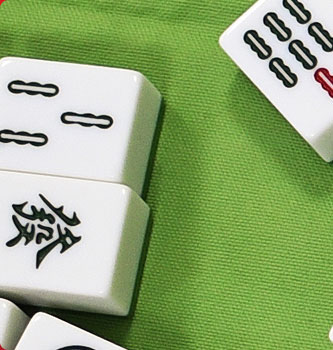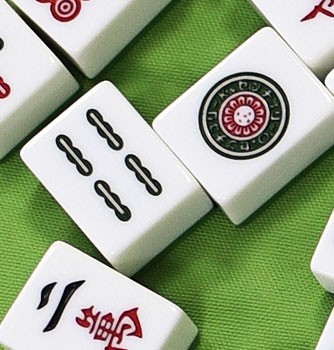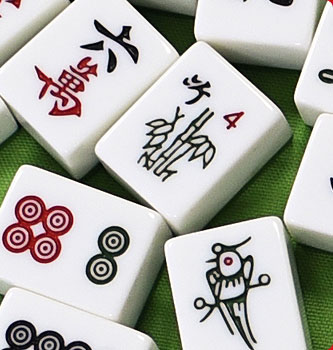Mahjiang Tiles
The number of Mahjiang tiles contained in a set varies from place to place. Usually, a Mahjiang set will have 144 tiles. Although some sets contain at least 136 tiles, American and Japanese Mahjiang sets will have more tiles.
Mahjiang tiles are grouped into the following categories:
Stick or Bamboo Tiles

Example of Stick or Bamboo Tiles
In earlier versions of Mahjiang, Stick tiles were illustrated as spears. Today, Stick tiles are also known as bamboo sticks or bamboo tiles ("suozi", or usually called "tiao", meaning "stick"). Each Mahjiang set usually have four sets of Stick tiles numbered from 1 through 9.
Note that the 1 of Sticks is generally rendered as the image of a bird - usually a sparrow or peacock.
Wheel or Dot Tiles

Example of Wheel or Dot Tiles
Before, wheel tiles were illustrated as coins or shields. Today, they are called wheels or dots ("tongzi"), some even call them balls. Each Mahjiang set usually have four sets of Wheel tiles numbered from 1 through 9.
Number or Character Tiles

Example of Number or Character Tiles
Number or Character tiles consist of the Chinese characters for the numerals 1 through 9 ("wanzi"), thus the name. The character on top of the tile face is the numeral; the character below that is the Chinese symbol "wan", meaning 10,000. Each Mahjiang set usually have four sets of Number tiles.
Wind Tiles

Example of Wind Tiles
Each Mahjiang set contains a group of tiles inscribed with the Chinese characters for the four winds: East ("dong"), South ("nan"), West ("xi"), and North (bei). There is four of each of these tiles in a set.
Dragon Tiles

Example of Dragon Tiles
These pieces are called "dragons" in the West: the red dragon (hongzhong), symbolizing the "middle" or "animal" order, including humans (zhong is the Chinese character meaning "center"), the green dragon (qingfa), symbolizing the "lower" or "plant" order of life, and the white dragon (baipi), symbolizing the "higher" order of spiritual beings).
There is four of each dragon tile in a Mahjiang set. Note that the "white dragon" tile is simply a plain white tile with or without a rectangular border drawn on it.
Flower Tiles

Example of Flower Tiles
There are eight Flower tiles ("huapai") in a Mahjiang set. While they are all collectively called "flower tiles", four of them represent different flower blossoms, while the other four represent the four seasons.
Each of these tiles represents a different flower, and is associated with a specific wind, which has relevance only for scoring purposes. There is only one of each flower tile in a Mahjiang set.
- Plum ("mei") - East
- Orchid ("lan") - South
- Chrysanthemum ("ju'") - West
- Bamboo ("zhu") - North
Season Tiles

Example of Season Tiles
Season Tiles are just like the flower tiles; Season Tiles do not enter play except to enhance the score of a player's hand. There is only one of each season tile.
- Spring ("chwen") - East
- Summer ("xia") - South
- Autumn ("qiu") - West
- Winter ("dong") - North
Don't worry too much about memorizing the appearance or characters of the flower and season tiles. Just remember the correspondence between the numbers on the tiles and the four wind directions:
- East
- South
- West
- North
Play Mahjiang Now!



